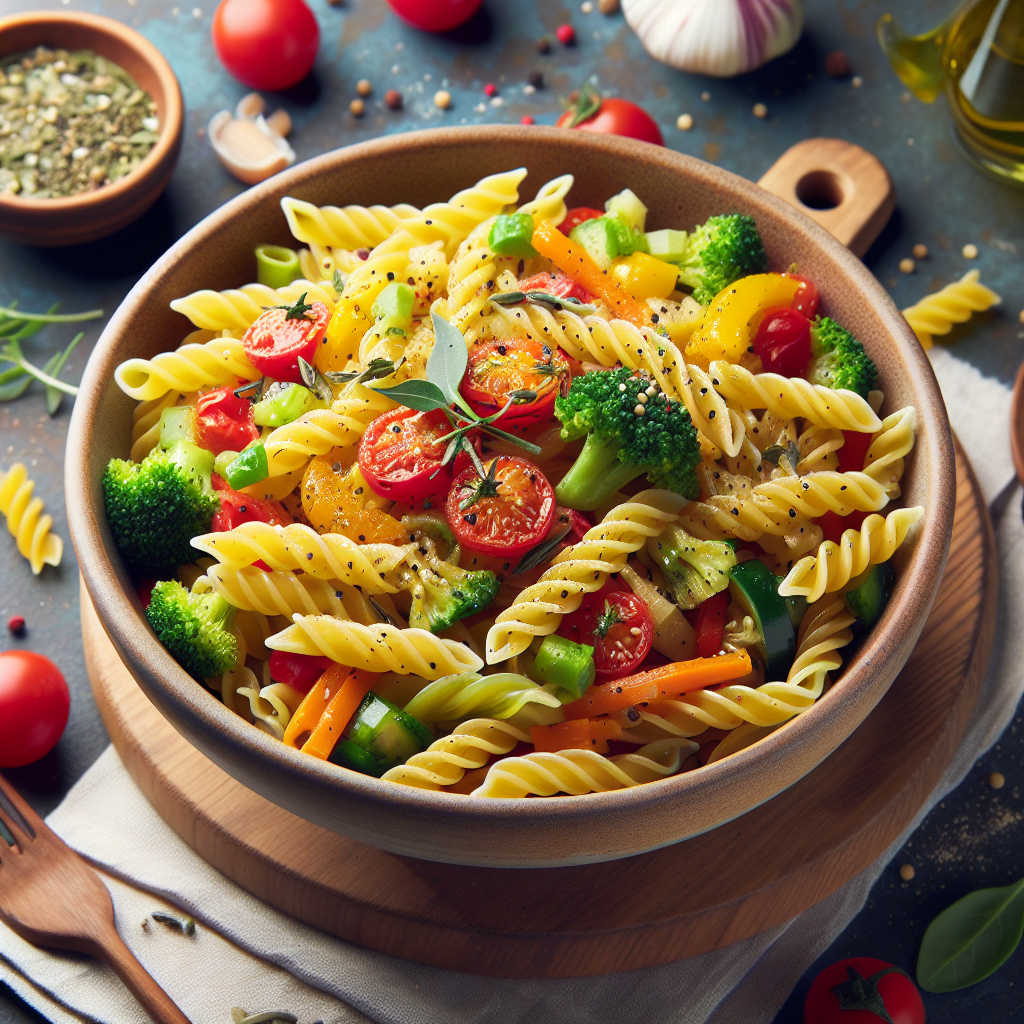Indulging in delicious pasta dishes while prioritizing your well-being is now easier than ever with Tastepan’s collection of gluten-free recipes. With expert advice and creative culinary solutions, you can now savor the art of gluten-free pasta without sacrificing flavor. Explore a wide array of tasty options that will nourish your body and satisfy your cravings, making healthy eating a breeze. Get ready to embark on a culinary journey that combines wholesome ingredients and delightful flavors in every bite.

The Basics of Gluten-Free Pasta
Understanding gluten
Before diving into the world of gluten-free pasta, it is essential to understand what gluten is. Gluten is a protein found in wheat, barley, and rye. It acts as a binding agent and is responsible for giving traditional pasta its characteristic chewy texture. However, for individuals with gluten intolerance or celiac disease, consuming gluten can cause severe digestive issues and other health problems.
What is gluten-free pasta?
Gluten-free pasta, as the name suggests, is pasta that does not contain gluten. It is made from alternative flours and ingredients that mimic the taste and texture of traditional pasta while being free from gluten. These alternatives can include rice flour, corn flour, quinoa flour, legume flours, and even buckwheat flour.
Benefits of gluten-free pasta
There are several benefits to incorporating gluten-free pasta into your diet. Firstly, it allows individuals with gluten intolerance or celiac disease to enjoy pasta without any adverse reactions. Secondly, gluten-free pasta options provide a wider variety of choices for those following a gluten-free lifestyle. Additionally, gluten-free pasta can often be easier on the digestive system, leading to improved digestion and nutrient absorption. Lastly, many people find that by reducing their gluten intake, they experience reduced inflammation and bloating, leading to enhanced overall well-being.
Popular Types of Gluten-Free Pasta
Rice pasta
Rice pasta is one of the most widely available and popular gluten-free pasta options. It is typically made from rice flour or a combination of rice and other gluten-free flours. Rice pasta holds its shape well and has a mild flavor that pairs well with a variety of sauces and toppings.
Corn pasta
For those who enjoy a touch of sweetness in their pasta, corn pasta is an excellent choice. Made from corn flour, it has a slightly golden hue and a delicate taste. Corn pasta tends to be less firm in texture compared to rice pasta but still holds up well when cooked properly.
Quinoa pasta
Quinoa, a highly nutritious grain-like seed, is the star ingredient in quinoa pasta. This gluten-free pasta is packed with protein, fiber, and various essential nutrients. Quinoa pasta has a slightly nutty flavor and a chewy texture that lends itself well to hearty sauces and bold flavors.
Legume-based pasta
Legume-based pasta, such as chickpea or lentil pasta, is gaining popularity for its high protein content and unique taste. These pastas are made from ground legumes and often contain other gluten-free flours for texture. They offer a great alternative for those looking to increase their protein intake while enjoying a pasta dish.
Buckwheat pasta
Despite its name, buckwheat is not related to wheat and is naturally gluten-free. Buckwheat pasta has a rich, nutty flavor and is often found in the form of Japanese soba noodles. It is a versatile option that complements various sauces and can be enjoyed both hot and cold.

Tips for Cooking Gluten-Free Pasta
Choosing the right cooking method
When it comes to cooking gluten-free pasta, choosing the right method is crucial to achieve the perfect texture. Boiling is the most common method, but some gluten-free pasta varieties may benefit from alternative methods like stir-frying or baking. It is important to follow the specific cooking instructions provided by the brand to ensure optimal results.
Follow the cooking instructions
Every brand and type of gluten-free pasta may have different cooking times and methods. It is essential to carefully read and follow the cooking instructions on the package. Overcooking or undercooking gluten-free pasta can result in a mushy or tough texture, so paying attention to the recommended cooking time is key.
Adding salt and oil to the boiling water
To enhance the flavor and prevent sticking, it is recommended to add salt and a small amount of oil to the boiling water before cooking gluten-free pasta. The salt adds flavor while the oil helps prevent the pasta from clumping together. Be sure to use gluten-free salt and oil if you are following a strict gluten-free diet.
Testing for doneness
Unlike traditional wheat-based pasta, gluten-free pasta can have varying cooking times and textures. To determine if the pasta is cooked to your desired level of doneness, it is best to remove a small piece and taste it. The pasta should be tender but still slightly firm (al dente) when cooked correctly.
Handling and storing cooked gluten-free pasta
After cooking, it is crucial to handle gluten-free pasta with care as it can be more delicate than traditional pasta. It is recommended to rinse the cooked pasta under cold water to stop the cooking process and remove any excess starch. Additionally, storing leftover gluten-free pasta in an airtight container in the refrigerator will help maintain its texture and flavor.
Delicious Gluten-Free Pasta Recipes
Classic spaghetti with gluten-free noodles
Ingredients:
- 8 ounces of gluten-free spaghetti noodles
- Your favorite marinara sauce
- Grated Parmesan cheese (optional)
- Fresh basil leaves for garnish
Instructions:
- Cook the gluten-free spaghetti according to the package instructions until al dente.
- Drain the cooked pasta and rinse it under cold water.
- Heat the marinara sauce in a separate saucepan.
- Add the cooked spaghetti to the saucepan and toss until well coated.
- Serve the spaghetti with your choice of grated Parmesan cheese and fresh basil leaves.
Creamy chicken Alfredo with rice pasta
Ingredients:
- 8 ounces of gluten-free rice fettuccine noodles
- 2 boneless, skinless chicken breasts, cooked and sliced
- 1 cup of heavy cream
- 1/2 cup of grated Parmesan cheese
- 2 tablespoons of butter
- Salt and pepper to taste
- Chopped parsley for garnish
Instructions:
- Cook the rice fettuccine noodles according to the package instructions until al dente.
- In a separate pan, melt the butter and add the heavy cream.
- Stir in the grated Parmesan cheese and season with salt and pepper.
- Add the cooked chicken to the sauce and heat through.
- Toss the cooked noodles with the creamy chicken Alfredo sauce.
- Garnish with chopped parsley before serving.
Spicy red lentil pasta with marinara sauce
Ingredients:
- 8 ounces of gluten-free red lentil penne noodles
- 1 jar of spicy marinara sauce
- 1 small onion, diced
- 2 cloves of garlic, minced
- Crushed red pepper flakes to taste
- Fresh basil leaves for garnish
Instructions:
- Cook the red lentil penne noodles according to the package instructions until al dente.
- In a separate pan, sauté the diced onion and minced garlic until fragrant.
- Add the jar of spicy marinara sauce and crushed red pepper flakes to the pan.
- Simmer the sauce for a few minutes to allow the flavors to blend.
- Toss the cooked noodles with the spicy marinara sauce.
- Garnish with fresh basil leaves before serving.
Pesto zucchini noodles with quinoa pasta
Ingredients:
- 1 medium-sized zucchini, spiralized into noodles
- 8 ounces of gluten-free quinoa spaghetti noodles
- 1/2 cup of homemade or store-bought pesto sauce
- Cherry tomatoes, halved
- Grated Parmesan cheese for garnish
Instructions:
- Cook the quinoa spaghetti noodles according to the package instructions until al dente.
- In a separate pan, sauté the zucchini noodles until tender.
- Drain the cooked quinoa spaghetti and toss it with the pesto sauce.
- Add the sautéed zucchini noodles and cherry tomatoes to the quinoa spaghetti.
- Mix well to combine all the ingredients.
- Garnish with grated Parmesan cheese before serving.
Buckwheat soba noodles with teriyaki tofu
Ingredients:
- 8 ounces of gluten-free buckwheat soba noodles
- 1 package of firm tofu, cubed
- 1/4 cup of gluten-free teriyaki sauce
- 2 green onions, chopped
- Sesame seeds for garnish
Instructions:
- Cook the buckwheat soba noodles according to the package instructions until al dente.
- In a separate pan, cook the cubed tofu until lightly golden.
- Add the gluten-free teriyaki sauce to the pan and stir to coat the tofu.
- Drain the cooked soba noodles and toss them with the teriyaki tofu.
- Add the chopped green onions and mix well.
- Garnish with sesame seeds before serving.

Enhancing the Flavor of Gluten-Free Pasta
Choosing flavorful sauces and toppings
To enhance the flavor of gluten-free pasta, it is essential to choose flavorful sauces and toppings. Opt for homemade or high-quality store-bought sauces that are gluten-free. Experiment with a variety of flavors such as marinara, Alfredo, pesto, or spicy arrabbiata sauce. Additionally, adding flavorful toppings like grated Parmesan cheese, fresh herbs, sautéed vegetables, or crispy bacon can take your gluten-free pasta dish to the next level.
Experimenting with herbs and spices
Herbs and spices are a fantastic way to add depth and complexity to gluten-free pasta dishes. Explore different combinations like basil, oregano, and garlic for a classic Italian flavor, or cilantro, cumin, and lime for a Mexican-inspired twist. Don’t be afraid to get creative and tailor the herbs and spices to your personal taste preferences.
Using quality ingredients
When cooking gluten-free pasta, using high-quality ingredients can make a significant difference in the final dish’s flavor. Choose fresh produce, lean proteins, and high-quality oils and sauces whenever possible. By using fresh and flavorful ingredients, you can elevate the taste of your gluten-free pasta dishes and create a more enjoyable dining experience.
Incorporating vegetables and proteins
Adding vegetables and proteins to your gluten-free pasta dishes not only enhances the flavor but also boosts the nutritional value. Incorporate a variety of colorful vegetables such as bell peppers, tomatoes, spinach, or broccoli to add texture and taste. For proteins, consider options like grilled chicken, shrimp, tofu, or beans to make your pasta dishes more satisfying and well-rounded.
Making Gluten-Free Pasta from Scratch
Gluten-free flour alternatives
When making gluten-free pasta from scratch, it is essential to use alternative flours that are free from gluten. Common gluten-free flour alternatives include rice flour, corn flour, quinoa flour, and buckwheat flour. Each flour has its unique properties, so experimenting with different combinations can help achieve the desired texture and flavor in homemade gluten-free pasta.
Combining gluten-free flours for the perfect texture
To achieve the perfect texture in homemade gluten-free pasta, it is often necessary to combine different gluten-free flours. For example, a combination of rice flour and corn flour can create a pasta dough that holds together well and has a pleasant flavor. It may require some trial and error to find the right combination of gluten-free flours that works best for the type of pasta you want to make.
The importance of xanthan gum
Xanthan gum is a common ingredient used in gluten-free baking and cooking, including pasta making. It acts as a binding agent and helps improve the texture and elasticity of gluten-free pasta dough. Adding a small amount of xanthan gum to the flour mixture can help mimic the chewy texture typically found in traditional pasta.
Rolling and cutting gluten-free pasta dough
When rolling and cutting gluten-free pasta dough, it is essential to work with smaller portions at a time. Gluten-free pasta dough can be more delicate and less elastic than wheat-based dough, making it more prone to tearing. Using a pasta machine can help ensure even thickness and make the rolling process easier. Be sure to dust the dough and the surface with gluten-free flour to prevent sticking.
Navigating Gluten-Free Pasta Brands
Researching reliable gluten-free pasta brands
With the increasing popularity of gluten-free diets, there are now numerous gluten-free pasta brands available in the market. However, not all brands are equal in terms of taste, texture, and cross-contamination risks. It is crucial to research and choose reliable gluten-free pasta brands that are certified gluten-free and have positive customer reviews.
Reading labels for hidden gluten
When selecting gluten-free pasta brands, it is important to carefully read the labels for any hidden sources of gluten. Some pasta brands may be labeled as gluten-free but manufactured in facilities that also process gluten-containing products, which can lead to cross-contamination. Look for clear labeling indicating that the pasta is free from gluten, wheat, barley, and rye to ensure it is safe for consumption.
Considering price and availability
Price and availability are also factors to consider when navigating gluten-free pasta brands. Gluten-free products, in general, tend to be more expensive than their gluten-containing counterparts. It is essential to strike a balance between the quality of the pasta and its affordability. Additionally, consider the availability of the brand in your local grocery stores or online platforms to ensure convenient access to your preferred gluten-free pasta brand.
Seeking recommendations and reviews
If you’re new to gluten-free pasta or unsure which brands to choose, seeking recommendations and reading customer reviews can be helpful. Ask friends, family, or online communities for their favorite gluten-free pasta brands and their experiences with various options. Taking the time to gather insights from others can lead you to discover new and trusted gluten-free pasta brands.
The Health Benefits of Gluten-Free Pasta
Suitable for people with gluten intolerance or celiac disease
The primary health benefit of gluten-free pasta is its suitability for individuals with gluten intolerance or celiac disease. For those with gluten-related disorders, consuming gluten can lead to severe digestive symptoms, damage to the small intestine, and long-term health complications. By opting for gluten-free pasta, individuals can enjoy a wide variety of pasta dishes without experiencing any adverse reactions.
Increased variety in the diet
Switching to gluten-free pasta opens up a world of culinary possibilities and encourages individuals to explore alternative ingredients and flavors. By incorporating different gluten-free pasta varieties into the diet, individuals can expand their meal options and diversify their nutrient intake. This increased variety can contribute to a more balanced and enjoyable diet overall.
Improved digestion and nutrient absorption
For some individuals, gluten can be difficult to digest, leading to digestive distress and nutrient malabsorption. By eliminating gluten from the diet and opting for gluten-free pasta, people with gluten sensitivity or celiac disease may experience improved digestion and enhanced nutrient absorption. This can contribute to better overall health and vitality.
Reduced inflammation and bloating
Gluten has been known to cause inflammation in some individuals, leading to discomfort and bloating. By choosing gluten-free pasta, people can reduce their intake of gluten and potentially experience reduced inflammation and bloating. This can result in increased comfort and overall well-being.
Common Mistakes to Avoid with Gluten-Free Pasta
Overcooking or undercooking gluten-free pasta
One common mistake when cooking gluten-free pasta is overcooking or undercooking it. As gluten-free pasta can have different cooking times and texture compared to traditional pasta, it is important to follow the cooking instructions provided on the packaging. Overcooking can lead to a mushy texture, while undercooking can result in a tough and unpleasant texture.
Not rinsing gluten-free pasta after cooking
Another mistake to avoid is not rinsing gluten-free pasta after cooking. Unlike traditional pasta, gluten-free pasta can become sticky due to the excess starch released during the cooking process. Rinsing the cooked pasta under cold water helps remove the excess starch and prevents the noodles from clumping together.
Using excessive oil or salt in the cooking process
While adding a small amount of oil and salt to the boiling water is recommended to prevent sticking and enhance flavor, it is important not to go overboard. Using excessive oil or salt can lead to a greasy or overly salty final dish. Stick to the recommended amounts and adjust according to personal taste preferences if needed.
Not following recommended storage guidelines
Properly storing cooked gluten-free pasta is crucial to maintaining its texture and taste. Failing to follow the recommended storage guidelines can result in a dry or rubbery texture. It is advisable to store cooked gluten-free pasta in an airtight container in the refrigerator and consume it within a few days.
Enjoying Gluten-Free Pasta with Confidence
Exploring new flavors and recipes
With the wide variety of gluten-free pasta options available, it is time to explore new flavors and recipes confidently. Try different pasta shapes, experiment with various sauces, and get creative with ingredients and toppings. Embrace the opportunity to discover exciting and delicious gluten-free pasta dishes that cater to your tastes and preferences.
Incorporating gluten-free pasta into your regular meal plan
Incorporating gluten-free pasta into your regular meal plan allows you to enjoy a diverse range of dishes without feeling restricted. With the growing availability of gluten-free options, it has become easier than ever to make gluten-free pasta a staple in your diet. Whether it’s a quick weeknight dinner or a weekend feast, gluten-free pasta can be a satisfying and enjoyable addition to your regular meals.
Sharing the experience with family and friends
Gluten-free pasta can be enjoyed by everyone, regardless of dietary restrictions. Sharing the experience of gluten-free pasta with family and friends can help promote inclusivity and open up conversations about different dietary preferences. Encourage your loved ones to try gluten-free pasta dishes, and they might be pleasantly surprised by the fantastic flavors and textures they discover.
Listening to your body’s needs and preferences
As with any dietary choice, it is essential to listen to your own body’s needs and preferences when it comes to gluten-free pasta. Pay attention to how your body reacts to different gluten-free pasta varieties and ingredients. This awareness can help you make informed choices and establish a personalized approach to incorporating gluten-free pasta into your lifestyle.
By understanding the basics of gluten-free pasta, experimenting with different types and cooking methods, exploring delicious recipes, enhancing the flavors, considering homemade options, researching reliable brands, and enjoying the many health benefits, you can confidently embrace gluten-free pasta as a versatile and satisfying addition to your culinary repertoire. Prioritize your well-being and savor the art of gluten-free pasta with its tasteful options.

